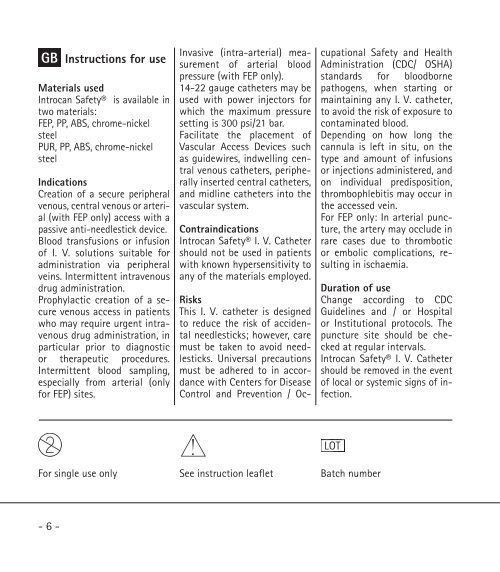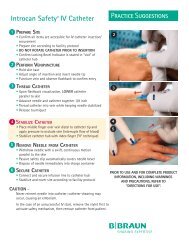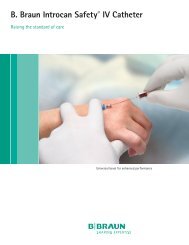Introcan Safety® Introcan Safety®-W - B. Braun Introcan Safety® IV ...
Introcan Safety® Introcan Safety®-W - B. Braun Introcan Safety® IV ...
Introcan Safety® Introcan Safety®-W - B. Braun Introcan Safety® IV ...
Create successful ePaper yourself
Turn your PDF publications into a flip-book with our unique Google optimized e-Paper software.
GB Instructions for use<br />
Materials used<br />
<strong>Introcan</strong> <strong>Safety®</strong> is available in<br />
two materials:<br />
FEP, PP, ABS, chrome-nickel<br />
steel<br />
PUR, PP, ABS, chrome-nickel<br />
steel<br />
Indications<br />
Creation of a secure peripheral<br />
venous, central venous or arterial<br />
(with FEP only) access with a<br />
passive anti-needlestick device.<br />
Blood transfusions or infusion<br />
of I. V. solutions suitable for<br />
administration via peripheral<br />
veins. Intermittent intravenous<br />
drug administration.<br />
Prophylactic creation of a secure<br />
venous access in patients<br />
who may require urgent intravenous<br />
drug administration, in<br />
particular prior to diagnostic<br />
or therapeutic procedures.<br />
Intermittent blood sampling,<br />
especially from arterial (only<br />
for FEP) sites.<br />
- 6 -<br />
Invasive (intra-arterial) measurement<br />
of arterial blood<br />
pressure (with FEP only).<br />
14-22 gauge catheters may be<br />
used with power injectors for<br />
which the maximum pressure<br />
setting is 300 psi/21 bar.<br />
Facilitate the placement of<br />
Vascular Access Devices such<br />
as guidewires, indwelling central<br />
venous catheters, peripherally<br />
inserted central catheters,<br />
and midline catheters into the<br />
vascular system.<br />
Contraindications<br />
<strong>Introcan</strong> <strong>Safety®</strong> I. V. Catheter<br />
should not be used in patients<br />
with known hypersensitivity to<br />
any of the materials employed.<br />
Risks<br />
This I. V. catheter is designed<br />
to reduce the risk of accidental<br />
needlesticks; however, care<br />
must be taken to avoid needlesticks.<br />
Universal precautions<br />
must be adhered to in accordance<br />
with Centers for Disease<br />
Control and Prevention / Oc-<br />
For single use only See instruction leaflet Batch number<br />
cupational Safety and Health<br />
Administration (CDC/ OSHA)<br />
standards for bloodborne<br />
pathogens, when starting or<br />
maintaining any I. V. catheter,<br />
to avoid the risk of exposure to<br />
contaminated blood.<br />
Depending on how long the<br />
cannula is left in situ, on the<br />
type and amount of infusions<br />
or injections administered, and<br />
on individual predisposition,<br />
thrombophlebitis may occur in<br />
the accessed vein.<br />
For FEP only: In arterial puncture,<br />
the artery may occlude in<br />
rare cases due to thrombotic<br />
or embolic complications, resulting<br />
in ischaemia.<br />
Duration of use<br />
Change according to CDC<br />
Guidelines and / or Hospital<br />
or Institutional protocols. The<br />
puncture site should be checked<br />
at regular intervals.<br />
<strong>Introcan</strong> <strong>Safety®</strong> I. V. Catheter<br />
should be removed in the event<br />
of local or systemic signs of infection.<br />
15327311_<strong>Introcan</strong>Safety_Booklet_6 6 27.10.2006 10:57:19 Uhr






